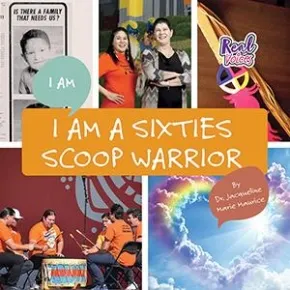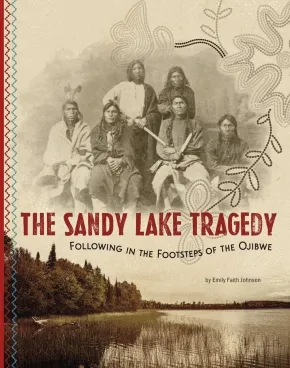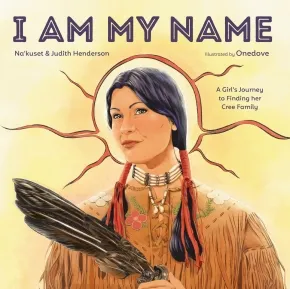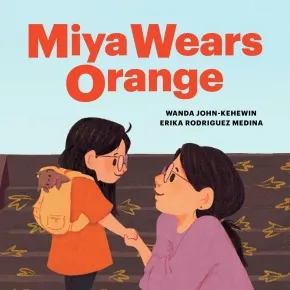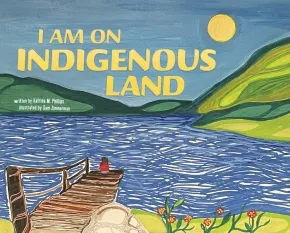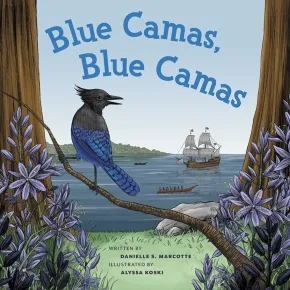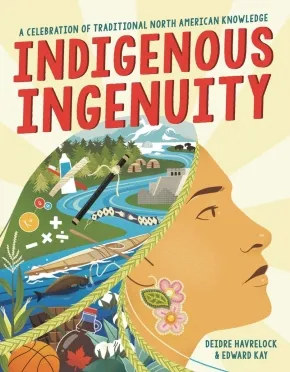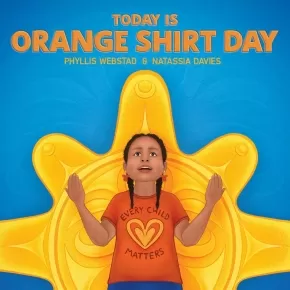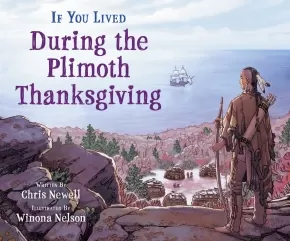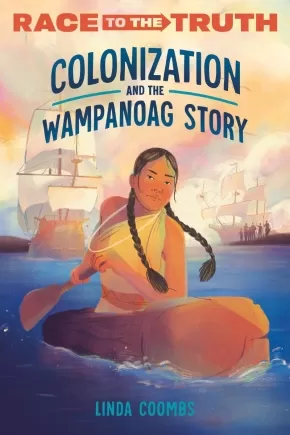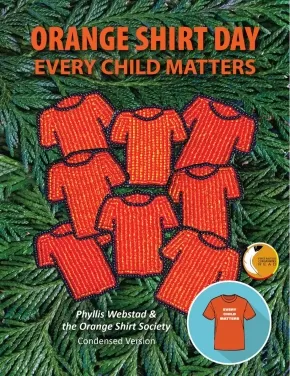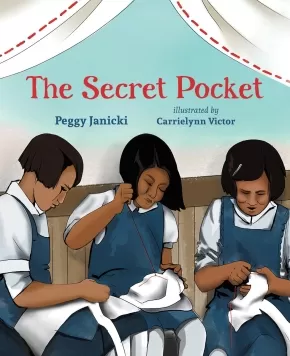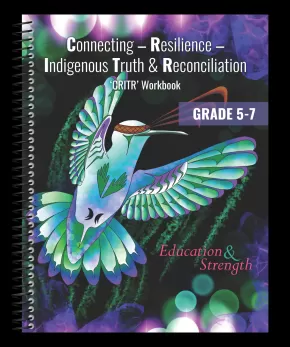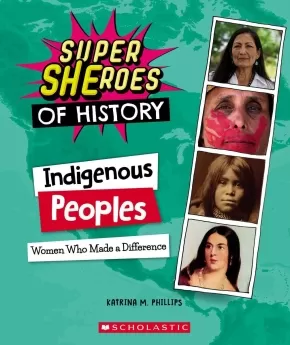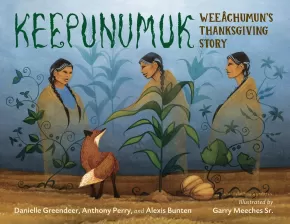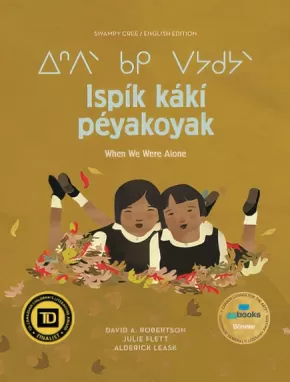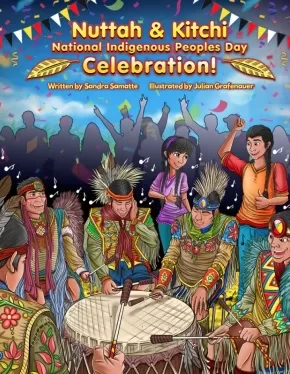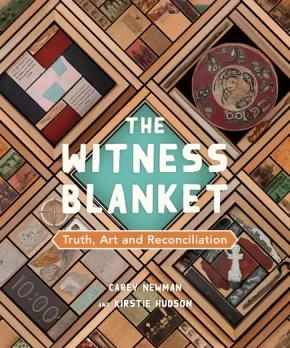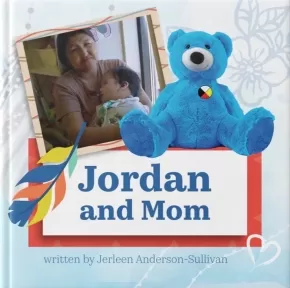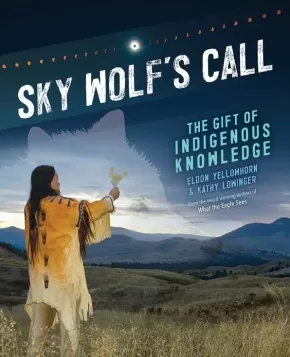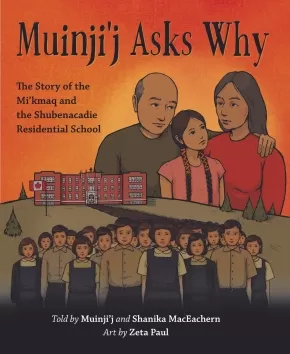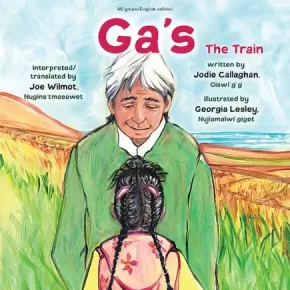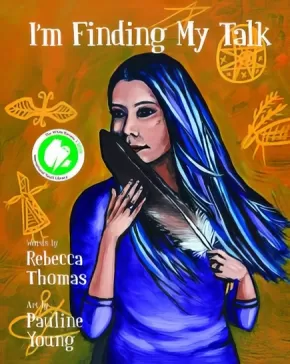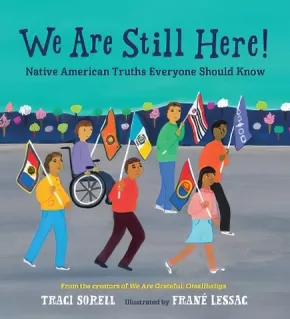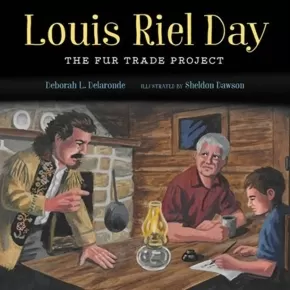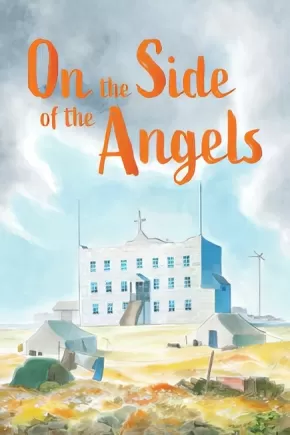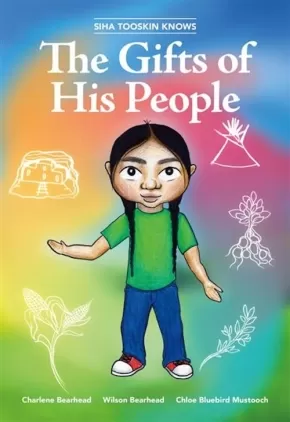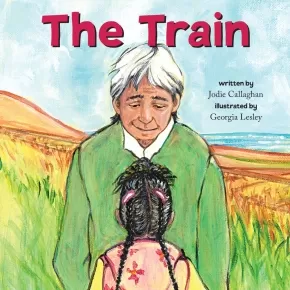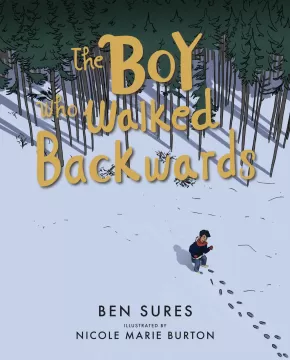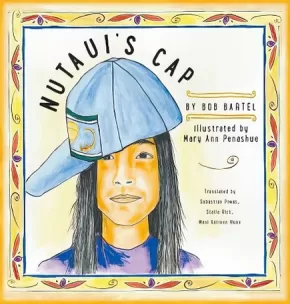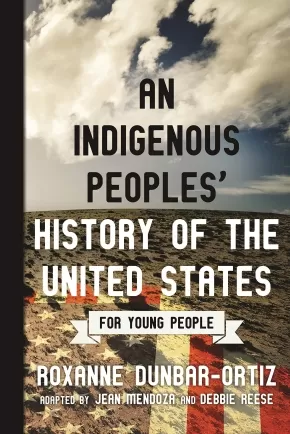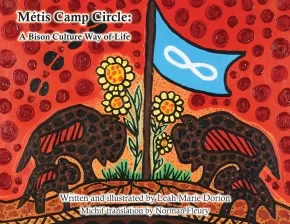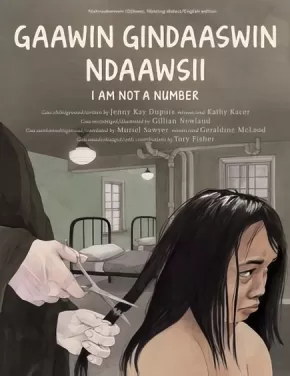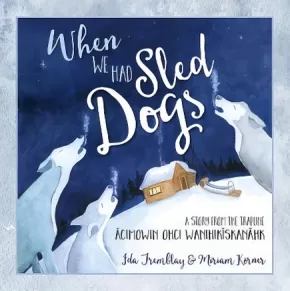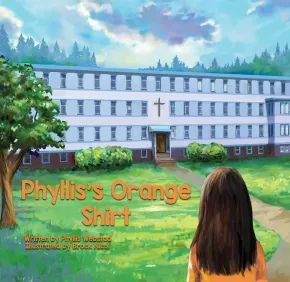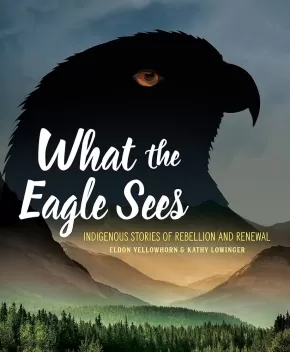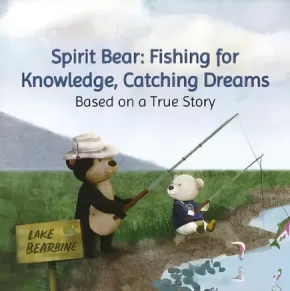
Indigenous History
1
-
15
of
63 Results;
Sort By
Go To
of 5
I Am a Sixties Scoop Warrior
$17.95
Format:
Paperback
Text Content Territories:
Indigenous Canadian; Métis;
ISBN / Barcode: 9781774569153
Synopsis:
Synopsis:
The Sixties Scoop is a dark part of Canada's history. Learn more about this time from someone who lived it. Jacqueline tells us more about her time as a child in the Sixties Scoop.
Educator Information
Juvenile Nonfiction
Additional Information
24 pages | Paperback
The Sandy Lake Tragedy: Following in the Footsteps of the Ojibwe
$13.99
Format:
Paperback
Text Content Territories:
Indigenous American; Native American; Anishinaabeg; Ojibwe (Chippewa);
ISBN / Barcode: 9798875206146
Synopsis:
Synopsis:
In 1850, 5,000 Ojibwe people were forced to make a dangerous journey across the Midwest to get treaty payments owed to them from the U. S. Government. But the payments never came, and the Ojibwe had to travel back home through treacherous winter conditions and without the money or supplies they had been promised. More than 400 Ojibwe lost their lives in this event that is now known as the Ojibwe Trail of Tears. Compelling narrative and impactful images help to recount the injustices of this forced removal and explain how it happened, what the many consequences were, how the Ojibwe people responded, and why this tragedy is still vitally relevant today. Author Emily Faith Johnson (Sault St. Marie Chippewa member) shares this not-to-be-forgotten story with young readers and educators seeking a closer look at U.S. history.
Educator Information
Recommended for ages 8 to 12.
Additional Information
32 pages | 8.00" x 10.00" | Paperback
I Am My Name: A Girl's Journey to Finding Her Cree Family
$26.99
Artists:
Text Content Territories:
Indigenous Canadian; First Nations; Cree (Nehiyawak);
ISBN / Barcode: 9780593648766
Synopsis:
Synopsis:
An evocative autobiographical picture book about Cree activist Na'kuset's life as a young girl taken from her home along with thousands of other indigenous children during the 1960s, and the journey of discovery that leads her to reclaim her life and culture.
I have come from somewhere else, where
I am Cree and I have a big sister
and another name.
One night, a very young girl was removed from her home during Canada’s Sixties Scoop, which tore children from their Indigenous communities. She woke in a new home, with a new family and a new name—her former life fading to a ghost of a memory. The only place she ever felt like she fit in was with her grandmother—her Bubbie—who listened to her and made her chicken soup and wrapped her in her loving arms. Until one day…the girl discovered the truth. And her beloved Bubbie helped her on her journey to claim her identity, her voice—and her name.
Together, Na'kuset and Judith Henderson tell the powerful story of the Indigenous experience for a child during the Sixities Scoop. Cree illustrator Onedove shared how inspired they are by Na'kuset's story and activism, and that is made evident in the tender and vivid illustrations that bring Na'kuset's story to life.
Educator Information
Recommendations for ages 6 to 9.
Lexile measure: 450L
Fountas & Pinnell Text Level Gradient: O
Additional Information
40 pages | 9.50" x 9.50" | Hardcover
Miya Wears Orange
$21.95
Artists:
Format:
Hardcover
Text Content Territories:
Indigenous Canadian; First Nations; Cree (Nehiyawak);
ISBN / Barcode: 9781774921258
Synopsis:
Synopsis:
A beautifully illustrated book that gently explores the complicated feelings a young girl experiences as she learns about tragedy and injustice.
Miya loves her school and she especially loves storytime. One day, her teacher shares a story about a little girl who was taken away to a residential school. The little girl wasn’t allowed to go home. Her hair was cut and she wasn’t allowed to keep her favourite doll. She was taken away from her family because she was Indigenous, just like Miya!
Miya worries the same thing will happen to her. Her mom tells her that Indigenous girls and boys aren’t forced to leave their families anymore. Miya is relieved, but she is still sad. What can she do about these feelings?
Reviews
"A moving and important story that deftly explores the fear a little Indigenous girl feels when she learns the truth about residential schools. Miya finds solace in her mom’s words, and readers will too. A sensitive explanation of residential schools that prioritizes the emotional safety of all readers, especially Indigenous children."— Jen Moss, lecturer at UBC's School of Creative Writing
"opens the door to an important discussion about residential schools" - School Library Journal
Educator Information
Recommended for ages 6 to 8.
In this story, a young girl named Miya feels scared and sad after learning about residential schools, but she learns how to cope with the help of her mother.
A gentle story about big feelings and finding courage.
Big Ideas: Social-Emotional Learning: Emotions and Feelings; Social Justice: Intergenerational Trauma, Residential Schools.
This book is available in French: Le Chandail orange de Miya.
Additional Information
40 pages | 8.50" x 8.50" | Hardcover
I Am on Indigenous Land
$25.99
Format:
Hardcover
Text Content Territories:
Indigenous American; Native American; Shawnee; Seminole; Salish; Coast Salish; Nisqually; Navajo (Diné); Ho-Chunk (Winnebago); Haudenosaunee (Iroquois); Tuscarora; Chickasaw; Blackfoot Confederacy (Siksikaitsitapi); Anishinaabeg; Ojibwe (Chippewa); Indigenous Caribbean; Taino;
ISBN / Barcode: 9781684363087
Synopsis:
Synopsis:
With simple, lyrical text and vibrant panoramic illustrations, this picture book explores the beauty and resources of thirteen ancestral Indigenous lands and how we all use those lands each day. Simple poetry and portrayals of children and families enjoying rivers, bike paths, beaches, and parks show how everyday activities can include honoring Indigenous nations and cultures.
Author Katrina Phillips (Ojibwe citizen) and illustrator Sam Zimmerman (Ojibwe direct descendant) together have crafted a loving tribute that gently demonstrates recognition and acknowledgement of the nations of people who first called these lands home.
Educator Information
Recommended for ages 3 to 9.
Additional Information
32 pages | 10.00" x 8.00" | Hardcover
Blue Camas, Blue Camas (PB)
$14.95
Format:
Paperback
Text Content Territories:
Indigenous Canadian; First Nations; Salish; Coast Salish; Songhees (Lekwungen);
ISBN / Barcode: 9781772035247
Synopsis:
Synopsis:
The captivating story of how the Blue Camas, a flower that has been cultivated on Canada’s west coast since time immemorial, came to symbolize the meeting of two contrasting ways of life and the perseverance of traditional knowledge against all odds.
Blue Camas, Blue Camas tells the story of a flower that is native to the Northwest Coast of North America. For thousands of years, it has been considered a sacred and valuable plant by the Indigenous Peoples of this region, who harvested and traded Blue Camas bulbs all along the west coast. At the height of this period, meadows would come alive with the bright wildflowers, which would attract dozens of species of butterflies and birds, and entire villages would work together to harvest the plant and ensure its continued growth.
When Europeans arrived and began to colonize the land, they did not see the value of the Blue Camas plant, and in fact saw the meadows where the plant had been harvested as ideal terrain to grow their own crops. The story takes place at the point of contact between a Lkwungen community and a group of Irish settlers, who see the land in very different ways.
This beautifully illustrated picture book is an ode to a way of life that was threatened and nearly destroyed through miscommunication and colonization. It also raises awareness for food rights, biodiversity, and the preservation of ecosystems, offering children and teachers the opportunity to discuss these important themes in an open and constructive way.
Reviews
"Blue Camas, Blue Camas is a captivating story revealing the overlooked history of colonial contact and its impact on Indigenous communities. Through vivid storytelling and diverse voices, it emphasizes land stewardship, cultural heritage, and fostering empathy, making it a valuable resource for children.”—Samantha Beynon, author of Oolichan Moon
“A beautiful story and an important narrative about the timeline of colonial contact . . . I am happy to share this book with my children.”—Sen’ákw, Senaqwila Wyss, Squamish Nation ethnobotanist
“Danielle S. Marcotte offers a rich, historical perspective of the amazing Blue Camas plant through the eyes of a First Nations family and a settler family.”—Teoni Spathelfer, Heiltsuk author of the Little Wolf Series
“This beautiful story weaves together a rich and important narrative. Family, nature, and the village are all intertwined, with the camas at the centre of it all. So simple and yet so poignant and true!”—Robert "Lucky" Budd, co-author (with Roy Henry Vickers) of the Northwest Coast Legends Series and A Is for Anemone: A First West Coast Alphabet
Educator Information
Recommended for ages 4 to 8.
Additional Information
48 pages | 9.00" x 9.00" | Paperback
Indigenous Ingenuity: A Celebration of Traditional North American Knowledge (PB)
$12.99
Artists:
Format:
Paperback
ISBN / Barcode: 9780316413435
Synopsis:
Synopsis:
Celebrate Indigenous thinkers and inventions with this beautifully designed, award-winning interactive nonfiction book—perfect for fans of Braiding Sweetgrass.
Corn. Chocolate. Fishing hooks. Boats that float. Insulated double-walled construction. Recorded history and folklore. Life-saving disinfectant. Forest fire management. Our lives would be unrecognizable without these, and countless other, scientific discoveries and technological inventions from Indigenous North Americans.
Spanning topics from transportation to civil engineering, hunting technologies, astronomy, brain surgery, architecture, and agriculture, Indigenous Ingenuity is a wide-ranging STEM offering that answers the call for Indigenous nonfiction by reappropriating hidden history. The book includes fun, simple activities and experiments that kids can do to better understand and enjoy the principles used by Indigenous inventors. Readers of all ages are invited to celebrate traditional North American Indigenous innovation, and to embrace the mindset of reciprocity, environmental responsibility, and the interconnectedness of all life.
Reviews
"An astonishing, exuberant treasure trove of history, science and hands-on activities that repeatedly begs the question: "Why didn't I know this?" Essential for kids and adults. We need this book." —Candace Fleming, award-winning author of The Rise and Fall of Charles Lindbergh and The Family Romanov
"This book will amaze readers and teachers as it demonstrates how pervasive and critical the history of Indigenous people is. A completely unique and important narrative not to be missed; readers and teachers will come away with a new appreciation for the myriad contributions Indigenous people have made."—SLJ, starred review
"A conversational tone invites readers to engage with this monumental collection . . . Curious readers will learn facts unique to individual tribal groups while gaining knowledge of STEM/STEAM concepts. An ambitious, appealing, and accessible work documenting and protecting valuable knowledge."—Kirkus Reviews
"Engaging and informative, this will be welcomed by both STEM and social studies curricula to help to correct prevailing narratives about Indigenous technology."—Booklist, starred review
"Via authoritative, meticulously researched prose, the creators detail Native peoples’ significant strides in scientific pursuits . . . [and] showcase Native tribes’ continual and enduring impact. Photographs, as well as interactive activities detailing recipes and science experiments, feature throughout, lending a hands-on approach to this clear and concise work."—Publishers Weekly
"This book is a valuable contribution to efforts to decolonize learning and introduce readers to the breadth of indigenous knowledge as practiced in widely disparate geographic zones."—Canadian Review of Materials
"An engaging and cleverly compiled guide to North American and Mesoamerican Indigenous innovation. STEM topics (housing, medicine, clothing, agriculture, and hunting among them) are compellingly and conversationally discussed."—Shelf Awareness
Educator Information
Recommended for ages 8 to 12.
Fountas & Pinnell Text Level Gradient: Z
Additional Information
288 pages | 6.95" x 9.00" | Paperback
Today is Orange Shirt Day (BB)
$13.95
Artists:
Format:
Board Book
Text Content Territories:
Indigenous Canadian; First Nations; Salish; Interior Salish; Secwepemc (Shuswap); Stswecem'c Xgat'tem;
Grade Levels: Preschool;
ISBN / Barcode: 9781778540363
Synopsis:
Synopsis:
Today, we gather together Today, we listen Today, we learn Today, we open our hearts
A first conversation about the importance of Orange Shirt Day - Every Child Matters and what little ones can expect to see and do on Orange Shirt Day - The National Day for Truth and Reconciliation.
An authentic, age-appropriate touch-and-feel board book designed for ages 0-3, written by the founder of the Orange Shirt Day movement and author of award-winning picture book Every Child Matters.
Orange Shirt Day is a day recognized annually on September 30th to honour Residential School Survivors, their families, and the children who did not come home.
Awards
- Silver IPPA Book Award Winner (First Nations/Indigenous Communities category)
Educator Information
Recommended for ages 0 to 3.
This book is available in French: La Journée du chandail orange, c'est aujourd'hui (BB)
Additional Information
24 pages | 7.00" x 7.00" | Board book
If You Lived During the Plimoth Thanksgiving
$11.99
Format:
Paperback
Text Content Territories:
Indigenous American; Native American; Wampanoag (Wôpanâak);
ISBN / Barcode: 9781338726367
Synopsis:
Synopsis:
What do you know about the thanksgiving feast at Plimoth?
What if you lived in a different time and place? What would you wear? What would you eat? How would your daily life be different?
Scholastic's If You Lived... series answers all of kids' most important questions about events in American history. With a question and answer format, kid-friendly artwork, and engaging information, this series is the perfect partner for the classroom and for history-loving readers.
What if you lived when the English colonists and the Wampanoag people shared a feast at Plimoth? What would you have worn? What would you have eaten? What was the true story of the feast that we now know as the first Thanksgiving and how did it become a national holiday?
Chris Newell answers all these questions and more in this comprehensive dive into the feast at Plimoth and the history leading up to it. Carefully crafted to explore both sides of this historical event, this book is a great choice for Thanksgiving units, and for teaching children about this popular holiday.
Reviews
"A welcome addition to the picture book history collection. ...The text does a remarkable job of giving larger context to the complexity of Indigenous life prior to colonization...This essential book should replace many established titles on the shelf." --School Library Journal (starred review)
"A measured corrective to pervasive myths about what is often referred to as the "first Thanksgiving." ...The lens Newell offers is a Native one, describing how the Wampanoag and other Native peoples received the English rather than the other way around. ...Essential." --Kirkus Reviews (starred review)
"A measured corrective to pervasive myths about what is often referred to as the "first Thanksgiving." ...The lens Newell offers is a Native one, describing how the Wampanoag and other Native peoples received the English rather than the other way around. ...Essential." --Kirkus Reviews (starred review)
Educator Information
Recommended for ages 7 to 10.
Additional Information
96 pages | 9.00" x 7.50" | Paperback
Discovering and Understanding The Métis
$24.99
Format:
Hardcover
Text Content Territories:
Indigenous Canadian; Métis;
ISBN / Barcode: 9782898244766
Synopsis:
Synopsis:
From their origins to their lives today, the Métis have so many things to tell us! Thanks to beautiful photos, illustrations, and texts written by experts, we can learn and understand more about the rich culture of the Métis.
Educator & Series Information
Recommended for ages 7 to 12.
This book is part of the Discovering and Understanding series.
Additional Information
32 pages | 8.66" x 10.62" | Hardcover
Colonization and the Wampanoag Story
$11.99
Format:
Paperback
Text Content Territories:
Indigenous American; Native American; Wampanoag (Wôpanâak);
ISBN / Barcode: 9780593480434
Synopsis:
Synopsis:
Until now, you've only heard one side of the story: the "discovery" of America told by Christopher Columbus, the Pilgrims, and the Colonists. Here's the true story of America from the Indigenous perspective.
When you think about the beginning of the American story, what comes to mind? Three ships in 1492, or perhaps buckled hats and shoes stepping off of the Mayflower, ready to start a new country. But the truth is, Christopher Columbus, the Pilgrims, and the Colonists didn't arrive to a vast, empty land ready to be developed. They arrived to find people and communities living in harmony with the land they had inhabited for thousands of years, and they quickly disrupted everything they saw.
From its "discovery" by Europeans to the first Thanksgiving, the story of America's earliest days has been carefully misrepresented. Told from the perspective of the New England Indigenous Nations that these outsiders found when they arrived, this is the true story of how America as we know it today began.
Reviews
"A poignant and powerful look at identity, change, and resiliency." —Kirkus Reviews
Educator Information
Recommended for ages 10+.
Additional Information
272 pages | 5.50" x 8.31" | Paperback
Orange Shirt Day: September 30th: Revised Edition
$32.99
Format:
Hardcover
Text Content Territories:
Indigenous Canadian; First Nations; Inuit; Métis;
ISBN / Barcode: 9781778540141
Synopsis:
Synopsis:
Orange Shirt Day, observed annually on September 30th, is also known as the National Day for Truth and Reconciliation. It is an official day to honour Residential School Survivors and their families, and to remember the children who did not come home. What was initially envisioned as a way to keep the conversations going about all aspects of Residential Schools in Williams Lake and the Cariboo Region of British Columbia, Canada, has now expanded into a movement across Turtle Island and beyond. Orange Shirt Day: September 30th aims to create champions who will walk a path of reconciliation and promote the message that 'Every Child Matters'. This award-winning book explores a number of important topics including the historical, generational, and continual impacts of Residential Schools on Indigenous Peoples, the journey of the Orange Shirt Day movement, and how you can effectively participate in the National Day for Truth and Reconciliation. With end of chapter reflection questions and a series of student art submissions, readers are guided to explore how they, and others, view and participate in Residential School reconciliation.
Awards
- 2021 First Nation Communities Read 2021 Winner
Educator Information
Recommended Ages: 10+
Orange Shirt Day was inspired by the story of a survivor named Phyllis Webstad. When Phyllis was 6 years old she went to residential school for the first time wearing a brand new shiny orange shirt. When she arrived at the school her shirt was taken away and never to be seen again. To Phyllis the colour orange was a symbol that she did not matter. Today she has learned to accept the colour and even have fun with it and now the orange shirt has become a symbol of hope and reconciliation. By wearing an orange shirt on Orange Shirt Day, you make a powerful statement that residential schools were wrong and commit to the concept that EVERY CHILD MATTERS.
The Orange Shirt Society is a non-profit organization with its home in Williams Lake, BC where Orange Shirt Day began in 2013. The society has both Indigenous and non-Indigenous board members, and one of the editors of this book, Phyllis Webstad, is Indigenous. Therefore, the Authentic Indigenous Text label has been applied. It is up to readers to determine if this book is authentic for their purposes.
This is the Revised 2023, 2nd Edition
Additional Information
156 pages | 8.23" x 11.06" | Revised, 2nd Edition
Orange Shirt Day: Every Child Matters: Condensed Edition
$19.99
Format:
Paperback
Text Content Territories:
Indigenous Canadian; First Nations; Inuit; Métis;
ISBN / Barcode: 9781778540158
Synopsis:
Synopsis:
A special abridged version of the award-winning book Orange Shirt Day: September 30th.
Orange Shirt Day, observed annually on September 30th, is also known as the National Day for Truth and Reconciliation. It is an official day to honour Residential School Survivors and their families, and to remember the children who did not come home. What was initially envisioned as a way to keep the conversations going about all aspects of Residential Schools in Williams Lake and the Cariboo Region of British Columbia, Canada, has now expanded into a movement across Turtle Island and beyond.
Orange Shirt Day: Every Child Matters aims to create champions who will walk a path of reconciliation and promote the message that 'Every Child Matters'. This version also explores a number of important topics including the historical, generational, and continual impacts of Residential Schools on Indigenous Peoples, the journey of the Orange Shirt Day movement, and how you can effectively participate in the National Day for Truth and Reconciliation. With end-of-chapter reflection questions and a series of student art submissions, readers are guided to explore how they, and others, view and participate in Residential School reconciliation.
Educator Information
Recommended for Young Adults (ages 10+)
This is an abridged version (condensed version) of Orange Shirt Day: September 30th.
This book is available in French: La journee du chandail orange: Chaque enfant compte
Additional Information
108 pages | 8.50" x 11.00" | Paperback
Nutshimit: In the Woods
$22.99
Artists:
Format:
Hardcover
Text Content Territories:
Indigenous Canadian; First Nations; Innu (Montagnais-Naskapi); Ekuanitshit; Inuit; Métis;
ISBN / Barcode: 9781039701809
Synopsis:
Synopsis:
In this immersive first-person account, Innu author Melissa Mollen Dupuis teams up with award-winning author and illustrator Elise Gravel to take readers on a journey through Innu culture, from creation legends to life today.
The Innu word Nutshimit signifies the physical and social space to practice traditional activities and language. Join author Melissa Mollen Dupuis on a guided walk deep through the forest to learn some of the rich culture of the Innu people.
Readers will discover the importance of natural world and learn a few Innu words along the way. Thoughtfully brought to life by Elise Gravel’s signature comic style illustrations, Melissa’s colloquial narrative and anecdotes detailing her lived experiences offer a deeply personal look at Innu life.
Educator Information
Recommended for ages 6 to 8.
Children learn Innu nature vocabulary through anecdotes from author’s lived experiences.
Populated with Elise Gravel’s hilarious characters and plenty of fun details.
This book is available in French: Nutshimit: Un bain de forêt
Find an activity book for this title here: Nutshimit: Activity Book
Additional Information
88 pages | 8.00" x 11.00" | Hardcover
The Secret Pocket
$21.95
Artists:
Format:
Hardcover
Text Content Territories:
Indigenous Canadian; First Nations; Dene; Dakelh (Carrier);
ISBN / Barcode: 9781459833722
Synopsis:
Synopsis:
The true story of how Indigenous girls at a Canadian residential school sewed secret pockets into their dresses to hide food and survive
Mary was four years old when she was first taken away to the Lejac Indian Residential School. It was far away from her home and family. Always hungry and cold, there was little comfort for young Mary. Speaking Dakelh was forbidden and the nuns and priest were always watching, ready to punish. Mary and the other girls had a genius idea: drawing on the knowledge from their mothers, aunts and grandmothers who were all master sewers, the girls would sew hidden pockets in their clothes to hide food. They secretly gathered materials and sewed at nighttime, then used their pockets to hide apples, carrots and pieces of bread to share with the younger girls.
Based on the author's mother's experience at residential school, The Secret Pocket is a story of survival and resilience in the face of genocide and cruelty. But it's also a celebration of quiet resistance to the injustice of residential schools and how the sewing skills passed down through generations of Indigenous women gave these girls a future, stitch by stitch.
Awards
- 2023 Sunshine Coast Writers and Editors Society (SCWES) Book Awards for BC Authors joint winner
- 2024 Forest of Reading Silver Birch Express Award
Reviews
“In bringing her mother’s story to the world, Peggy Janicki has ignited a powerful fire for intergenerational healing. A vivid illustration of how Traditional Knowledge helped the children at residential schools be heroes for themselves and each other. Not only has Janicki meticulously documented everyday life as experienced by the students of the Lejac residential school but she has also highlighted their ingenious and courageous efforts to survive. Strengths-based, age-appropriate and vividly engaging.”— Christy Jordan-Fenton, award-winning author of Fatty Legs
“Beautifully illustrated and powerfully narrated, The Secret Pocket amplifies the voices and experiences of Indian Residential School Survivors. In doing so, Peggy Janicki and Carrielynn Victor make an important contribution to the work of putting truth before reconciliation.”— Sean Carleton, historian and author of Lessons in Legitimacy: Colonialism, Capitalism, and the Rise of State Schooling in British Columbia
“In this important story of courage and resistance, educator Peggy Janicki shares the story of her mother and other Survivors who sewed secret pockets into their dresses to hide food to feed themselves and others at Lejac residential school. We need to continue to hear these stories and share them with our children so we can move forward in our collective healing.”— Dr. Sara Florence Davidson, co-author of Potlach as Pedagogy: Learning Through Ceremony
“It is through stories that knowledge, understanding, empathy and the tools for deep and lasting change are passed on. Peggy Janicki has carried her mother’s story for us to hold in our hearts. This truth-telling and history-sharing will touch readers of all ages as they allow themselves to feel the weight of this powerful book.”— Amber Price, MGC, owner of The Book Man
Educator Information
Recommended for ages 6 to 8.
This book is available in French: La poche secrète.
Additional Information
32 pages | 8.75" x 10.75" | Hardcover
Connecting – Resilience – Indigenous Truth & Reconciliation ‘CRITR’ Workbook: Grade 5 - 7
$29.95
Artists:
Format:
Coil Bound
Text Content Territories:
Indigenous Canadian; First Nations; Inuit; Métis;
ISBN / Barcode: 9781990448348
Synopsis:
Synopsis:
CRITR provides dozens of lessons and 100s of questions covering important topics including: Indigenous Canadian History, Residential Schools, Indigenous Contributions past and present, Treaties, and Indigenous Days of Recognition in Canada.
This book is a collection of parts of the history of the Indigenous Peoples in Canada and of the process of reconciliation. It is designed to educate all children and youth -- our future leaders -- about Indigenous history and current events. It is intended to give a better understanding and to positively contribute to reconciliation.
Together, we must consider the past, the present, and the future in our efforts to better ourselves and future generations.
This book provides a wealth of high-quality articles and learning activities, consisting of units and lessons that can be used by anyone -- teachers, parents, students, business professionals -- who may have little or no prior knowledge or understanding of Indigenous Peoples or subjects.
In this book, you will meet real Indigenous Peoples speaking out and sharing their stories and their firsthand experiences, and you will clearly hear their passion for reconciliation.
This book is unique. The stories told within its covers are unique, just like everyone working through their own journey of understanding and doing their small part towards reconciliation.
“We need to pursue reconciliation consistently and passionately. Education has gotten us into this mess, and education will get us out. We see this as our challenge and our hope.” -The Honourable Senator Murray Sinclair
Educator Information
Recommended for grades 5 to 7.
CRITR Workbook Features
- Indigenous knowledge from different Indigenous Peoples and Indigenous perspectives.
- Dozens of lessons covering important topics including Residential Schools, Treaties, and Indigenous Contributions.
- Beautiful original art on the cover and throughout the book.
- An Indigenous worldview expressing people's need to develop themselves and their children, in a way that addresses their spiritual, physical, emotional, and mental gifts.
- An approach to the teaching and healing process that is interconnected and cyclical in nature.
- An introduction to readers of the concept of a "sacred circle," also known as a medicine wheel, as well as First Peoples' principles of learning in general terms.
- Words of encouragement.
- A balance between too much and too little content.
- Information and a layout to inform and inspire without overwhelming the teacher or the student, in the classroom or at home.
- Fresh insights and learning activities for key Indigenous events that are celebrated annually in schools and communities across the Nation.
- Critical thinking questions to inspire new learning.
- Activities for individuals and groups.
- The font in the grade 5 to 7 book is ideal for young readers ( Arial 13.5-point font). Additionally, the grade 5 to 7 book features shorter sentence structure for easy reading and comprehension.
- A few activities and lessons featured in the grade 8 to 12 resource have been changed or removed in the grade 5 to 7 book due to the maturity level of the subject matter.
- Grade-level appropriate word choices to help with improved vocabulary.
How is the CRITR workbook organized?
Each lesson follows this pattern:
- An easy-to-read lesson that may be read in under 5 minutes
- A vocabulary focus called Word Power that defines key words from the lesson
- A set of questions easily answered from the reading
- A Critical Thinking section is included to enhance learning
- Sprinkled throughout the CRITR Workbook are relevant individual and group activity recommendations.
Additional resources are identified throughout the pages with links, including information about how to connect with the Indigenous authors and artists.
Activities, colouring, and word search pages may be downloaded for free. An answer key is included at the end of the book.
What will students learn from this resource?
- Reconciliation is about change, justice, respect, and re-building the relationships between the Indigenous and non-Indigenous Peoples in Canada
- Indigenous History of Canada
- Empathy that comes from understanding and being educated
- Knowledge about important and sensitive topics, including stories told by Indigenous authors about what occurred at residential schools. It is important to know these stories of assimilation
- Capacity for intercultural understanding, empathy, and mutual respect as prescribed specifically in CTA #63
Educator Information
For grades 5 to 7.
A $5 per book discount is applied to a purchase of 10 or more books.
This book is available in French: Connexion - Résilience - Vérité et réconciliation autochtones Ressource - 5e à 7e année
Additional Information
176 Pages | 9" x 11.5" x 0.5" | Spiral Bound
Super SHEroes of History: Women Who Made a Difference (Indigenous Peoples)
$9.99
Format:
Paperback
Text Content Territories:
Indigenous American; Indigenous Canadian;
ISBN / Barcode: 9781338840742
Synopsis:
Synopsis:
Meet the Super SHEroes of History, the women who have shaped history and society since ancient times.
Indigenous women were prominent members of their communities long before Europeans reached North America. When the newcomers arrived, they played a key role in holding their communities together in the face of social turmoil. Some joined male warriors to fight European settlement, while others such as Nanyehi/Nancy Ward argued that the two peoples could coexist peacefully. Indigenous women led political and legal fights to preserve their traditional rights throughout the 20th century and still do so today. Some became active campaigners in numerous causes, especially in the struggle to protect sacred lands from construction. This book tells their stories and describes their vital contributions.
Educator Information
Recommended for ages 8 to 12.
Additional Information
48 pages | 7.12" x 8.37" | Paperback
Keepunumuk: Weeachumun's Thanksgiving Story
$22.99
Artists:
Format:
Hardcover
Text Content Territories:
Indigenous American; Native American; Wampanoag (Wôpanâak); Mashpee Wampanoag Tribe;
ISBN / Barcode: 9781623542900
Synopsis:
Synopsis:
In this Wampanoag story told in a Native tradition, two kids from the Mashpee Wampanoag tribe learn the story of Weeâchumun (corn) and the first Thanksgiving.
The Thanksgiving story that most Americans know celebrates the Pilgrims. But without members of the Wampanoag tribe who already lived on the land where the Pilgrims settled, the Pilgrims would never have made it through their first winter. And without Weeâchumun (corn), the Native people wouldn't have helped.
An important picture book honoring both the history and tradition that surrounds the story of the first Thanksgiving.
Reviews
"A Wamponoag grandmother plants her garden with weeâchumun (corn), beans, and squash, or the Three Sisters. When her grandchildren ask to hear the story of Thanksgiving, N8hkumuhs tells them that their people call it Keepunumuk, “the time of harvest,” and explains what really happened. The tale opens with Seagull warning Weeâchumun—depicted as a woman with a translucent body—of the Pilgrims’ arrival; Weeâchumun worries because many of the First Peoples who cared for her have gone to the Spirit World, and she fears this will be her last winter. Fox keeps an eye out and in spring tells Weeâchumun and her sisters that the newcomers endured a hard winter; many died. Weeâchumun and her sisters want to help: “We will send the First Peoples to help the newcomers.” The Wampanoag people teach the survivors how to plant corn, beans, and squash. The settlers hold a feast to celebrate the harvest; though it’s remembered by many as the first Thanksgiving, backmatter explains that because of the disease and warfare brought by the settlers, for the Wampanoag people, it is remembered as a day of mourning. Rich, saturated acrylics imbued with a touch of magic add to the vibrancy of this important, beautiful story. A much-needed Thanksgiving retelling that centers the Wamponoag people. (glossary, information on the Wampanoag map, recipes) (Picture book. 3-7)" —Kirkus, starred review
"This picture book features a contemporary Wampanoag grandmother and her grandchildren. N8hkumuhs shares the story of the Three Sisters—Corn, Beans, and Squash—and the first Thanksgiving, known as “Keepunumuk” by the Wampanoag people. The book transitions into a combination of history and storytelling about contact between the “First Peoples” and the newcomers. This format will be novel to some young children given the setting and timeframe of the story, though the book attempts to differentiate the parts that are the story by changing the typeface and including ethereal-like images of the Three Sisters. “Before You Begin” and “Important Words to Know” sections also provide context. Rich back matter includes more information about the Wampanoag tribes, a traditional recipe, and a photo and information about the real Maple and Quill, the grandchildren in the story. Overall, this story is a good addition for the historical knowledge of the first Thanksgiving from the Wampanoag viewpoint. VERDICT: A good choice for libraries striving to share Indigenous perspectives."— School Library Journal
Additional Information
32 pages | 11.38" x 8.81" | Hardcover
Ispík kákí péyakoyak/When We Were Alone
$21.95
Artists:
Format:
Hardcover
Text Content Territories:
Indigenous Canadian; First Nations; Cree (Nehiyawak); Swampy Cree ;
ISBN / Barcode: 9781553799054
Synopsis:
Synopsis:
An empowering story of resistance that gently introduces children to the history of residential schools in Canada.
A young girl notices things about her grandmother that make her curious. Why does her grandmother have long, braided hair and beautifully coloured clothing? Why does she speak Cree and spend so much time with her family? As she asks questions, her grandmother shares her experiences in a residential school, when all of these things were taken away.
When We Were Alone won the 2017 Governor General's Literary Award in the Young People's Literature (Illustrated Books) category, and was nominated for the TD Canadian's Children's Literature Award. This edition includes the text in Swampy Cree syllabics and Roman orthography, as well as the original English.
Reviews
"When We Were Alone is a story about finding the strength to push forward when everything is against you. It follows a young girl asking her grandmother questions to learn more about her past. The grandmother shares her experience of a time when she was unable to make her own decisions and how she got through it." — The Dalai Lama Center
Educator Information
Recommended for ages 6 to 8.
This edition includes the text in Swampy Cree syllabics and Roman orthography, as well as the original English.
Translated by Alderick Leask. Alderick Leask is a respected Swampy Cree language instructor originally from Sapotaweyak Cree Nation, Manitoba. His experience includes conducting classes in Native Studies, Native Cultures, Native Languages and Canadian History from the Indigenous perspective using Traditional Elders’ Knowledge (TEK) and land-based learning. Mr. Leask places Creation and its bounties as his background in instructing students when learning basic outdoor survival skills. His usage of the functional and descriptive language of Swampy Cree demonstrates its practicality.
This book is available in an English-only format: When We Were Alone
This resource is also available in French: Quand on etait seuls
Additional Information
32 pages | 7.50" x 10.00" | Hardcover
Nuttah & Kitchi National Indigenous Peoples Day Celebration Activity Book
$9.95
Artists:
Format:
Paperback
Text Content Territories:
Indigenous Canadian; First Nations; Inuit; Métis;
ISBN / Barcode: 9781990297007
Synopsis:
Synopsis:
Companion book to Nuttah and Kitchi National Indigenous Peoples Day Celebration, featuring Indigenous Teachings and Fun Activities for Everyone!
Both resources are written by Sandra Samatte, Ojibwe - Saulteaux - from Skownan First Nation Treaty 2 Territory and illustrated by Julian Grafenauer, Ojibwe from Rolling River First Nation. Come celebrate and explore with Nuttah and Kitchi on June 21st, the first day of summer as they experience all the exciting fun-filled activities and events that take place on National Indigenous Peoples Day.
Educator Information
Recommended for grades 2 to 5.
Find the companion book here: Nuttah & Kitchi National Indigenous Peoples Day Celebration
Additional Information
32 Pages | Paperback
Nuttah & Kitchi National Indigenous Peoples Day Celebration
$14.99
Artists:
Format:
Paperback
Text Content Territories:
Indigenous Canadian; First Nations; Inuit; Métis;
ISBN / Barcode: 9780993937194
Synopsis:
Synopsis:
Nuttah and Kitchi National Indigenous Peoples Day Celebration is written by Sandra Samatte, Ojibwe - Saulteaux - from Skownan First Nation Treaty 2 Territory and illustrated by Julian Grafenauer, Ojibwe from Rolling River First Nation.
Come celebrate and explore with Nuttah and Kitchi on June 21st, the first day of summer as they experience all the exciting fun-filled activities and events that take place on National Indigenous Peoples Day.
Educator Information
Recommended for grades 2 to 5.
A companion activity book is available: Nuttah & Kitchi National Indigenous Peoples Day Celebration Activity Book: Indigenous Teachings and Fun Activities for Everyone
Additional Information
32 Pages | Paperback
The Witness Blanket: Truth, Art and Reconciliation
$24.95
Format:
Hardcover
Text Content Territories:
Indigenous Canadian;
ISBN / Barcode: 9781459836129
Synopsis:
Synopsis:
For more than 150 years, thousands of Indigenous children were taken from their families and sent to residential schools across Canada.
Artist Carey Newman created the Witness Blanket to make sure that history is never forgotten. The Blanket is a living work of art—a collection of hundreds of objects from those schools. It includes everything from photos, bricks, hockey skates, graduation certificates, dolls and piano keys to braids of hair. Behind every piece is a story. And behind every story is a residential school Survivor, including Carey's father. This book is a collection of truths about what happened at those schools, but it's also a beacon of hope and a step on the journey toward reconciliation.
Educator Information
Recommended for ages 9 to 12.
Additional Information
112 pages | 7.50" x 9.00" | Hardcover
Jordan and Mom
$14.99
Format:
Paperback
Text Content Territories:
Indigenous Canadian; First Nations; Cree (Nehiyawak); Swampy Cree ; Norway House Cree Nation;
Grade Levels: 8;
ISBN / Barcode: 9781990297533
Synopsis:
Synopsis:
Jerleen Sullivan Anderson from Norway House Cree Nation shares the story of her brother Jordan River Anderson and their Mom Virgina Anderson in her book Jordan and Mom.
Jerleen writes this book so that we can remember Jordan and the way he was treated as a First Nations child, with his serious health condition, by the governments of Manitoba and Canada. It is a book for us to learn and understand how Jordan’s Principle came about and that Jordan had a Mom and family who loved him dearly.
Educator Information
The publisher recommends this picture book for grades seven, eight, and nine.
Keywords / Themes: Jordan's Principle; Health; Family.
Additional Information
24 Pages | Paperback
Sky Wolf's Call: The Gift of Indigenous Knowledge
$16.95
Format:
Paperback
Text Content Territories:
Indigenous Canadian; Indigenous American;
ISBN / Barcode: 9781773216294
Synopsis:
Synopsis:
From healing to astronomy to our connection to the natural world, the lessons from Indigenous knowledge inform our learning and practices today.
How do knowledge systems get passed down over generations? Through the knowledge inherited from their Elders and ancestors, Indigenous Peoples throughout North America have observed, practiced, experimented, and interacted with plants, animals, the sky, and the waters over millennia. Knowledge keepers have shared their wisdom with younger people through oral history, stories, ceremonies, and records that took many forms.
In Sky Wolf’s Call, award-winning author team of Eldon Yellowhorn and Kathy Lowinger reveal how Indigenous knowledge comes from centuries of practices, experiences, and ideas gathered by people who have a long history with the natural world. Indigenous knowledge is explored through the use of fire and water, the acquisition of food, the study of astronomy, and healing practices.
Reviews
"An authoritative tribute to Indigenous knowledge systems that's a must-have for every library and classroom." - Kirkus Reviews
“Sky Wolf’s Call has an astoundingly broad scope introducing Indigenous Traditional Ecological Knowledge (TEK) in North America from time immemorial to the current day … This fast paced celebration of Indigenous innovation and technology is riveting.” - The British Columbia Review
Educator Information
Interest Age: 11+
Grade: 6+
Reading Age: 11+
A Junior Library Guild Gold Standard Selection
Table of Contents
Author’s Note
1: Sky Wolf’s Call: The Gift of Indigenous Knowledge: Foundational ideas behind Indigenous Knowledge and the importance of retaining, maintaining, and learning this sacred knowledge.
2: Water Knowledge Ways: Water links us all and is sacred. Indigenous people have fought to protect the gift of water from harm, and the critical role it has played in transportation, agriculture, irrigation, and food.
3: Fire and Smoke Knowledge: Fire and smoke are great gifts, including the burning of tobacco. In sacred ceremonies, smoke connects our breath with the heavens. Fire cooks our food, helps grow our crops, and even keeps our waters clean. Cultural burns are used to benefit the land.
4: Indigenous Knowledge and Food Security: Sharing, growing, and receiving food with family, community, and visitors is both an honour and a tradition. By understanding the traditional practices of salmon fishing, clam gardens, planting and harvesting certain crops, or hunting buffalo, Indigenous Peoples have respected what Mother Earth has to offer.
5: Healing Knowledge Ways: The use of the medicine wheel and the sweat lodge have been used over centuries and still help sick and troubled people. Games such as lacrosse and chunkey have helped in building individual strength and community spirit. And braiding together Indigenous healing and western science has opened new learning opportunities.
6: Sky Knowledge: From the earliest Indigenous astronomers to modern astrophysicists, these sky watchers have studied the sacred gifts of the sky: the sun, moon, planets, and stars that have produced maps, calendars, beliefs about how to govern, and even directions for building homes.
7: Keeping the Knowledge: Indigenous People hold oral narratives in high esteem because that was the way knowledge passed from one generation to the next. People in North America recorded important events with symbols, pictographs (paintings), and petroglyphs (carvings). Language Keepers and Knowledge keepers are making sure that Indigenous knowledge is never forgotten.
8: Sky Wolf’s Call: Indigenous knowledge is based on the idea that this world is a gift. Understanding the idea of connections (the skies with the earth, people with animals, the practical with the spiritual) is an important lesson with the challenges of climate change, pandemics, and wars. The wisdom of Indigenous Knowledge can help the whole world.
Thanks and Acknowledgments
Glossary
Selected Reading
Sources and Contacts
Additional Information
120 pages | 7.50" x 9.25" | Paperback
Muinji'j Asks Why: The Story of the Mi'kmaq and the Shubenacadie Residential School
$22.95
Artists:
Format:
Paperback
Text Content Territories:
Indigenous Canadian; First Nations; Mi'kmaq;
ISBN / Barcode: 9781774710470
Synopsis:
Synopsis:
An educational and heartfelt retelling of the story of the Mi'kmaq and their traditional lands, Mi'kma'ki, for young readers, focused on the generational traumas of the Indian Residential School System.
"The story of the Mi'kmaw people is one that very few truly know, Ladybug. Even fewer understand what happened at the residential schools. It is a hard story to tell, but you must know the truth. Sit and I will tell you the story."
When seven-year-old Muinji'j comes home from school one day, her Nana and Papa can tell right away that she's upset. Her teacher has been speaking about the residential schools. Unlike most of her fellow students, Muinji'j has always known about the residential schools. But what she doesn't understand is why the schools existed and why children would have died there.
Nana and Papa take Muinji'j aside and tell her the whole story, from the beginning. They help her understand all of the decisions that were made for the Mi'kmaq, not with the Mi'kmaq, and how those decisions hurt her people. They tell her the story of her people before their traditional ways were made illegal, before they were separated and sent to reservations, before their words, their beliefs, and eventually, their children, were taken from them.
A poignant, honest, and necessary book featuring brilliant artwork from Mi'kmaw artist Zeta Paul and words inspired by Muinji'j MacEachern's true story, Muinji'j Asks Why will inspire conversation, understanding, and allyship for readers of all ages.
Educator Information
Juvenile Nonfiction
Additional Information
40 pages | Paperback
Ga's / The Train
$19.95
Artists:
Format:
Hardcover
Text Content Territories:
Indigenous Canadian; First Nations; Mi'kmaq;
ISBN / Barcode: 9781772602005
Synopsis:
Synopsis:
The dual-language edition, in English and Mi'gmaq, of the Silver Birch Express-nominated title, The Train.
Ashley meets her great-uncle by the old train tracks near their community in Nova Scotia. Ashley sees his sadness, and Uncle tells her of the day years ago when he and the other children from their community were told to board the train before being taken to residential school where their lives were changed forever. They weren't allowed to speak Mi'gmaq and were punished if they did. There was no one to give them love and hugs and comfort. Uncle also tells Ashley how happy she and her sister make him. They are what give him hope. Ashley promises to wait with her uncle by the train tracks, in remembrance of what was lost.
Educator Information
This is the dual-language (Mi'gmaq and English) version of The Train.
Recommended for ages 6 to 9.
Additional Information
36 pages | 8.50" x 8.50" | Translated by Joe Wilmot | Hardcover
Orange Shirt Day Book Package
$92.99
Artists:
Text Content Territories:
Indigenous Canadian; First Nations; Salish; Interior Salish; Secwepemc (Shuswap); Stswecem'c Xgat'tem;
ISBN / Barcode: 9781989122808
Synopsis:
Synopsis:
A collection of authentic Orange Shirt Day books from the founder of the Orange Shirt Day movement, Phyllis Webstad. Package includes four books and three accompanying lesson plans, The Orange Shirt Story, Phyllis's Orange Shirt, Orange Shirt Day and Beyond the Orange Shirt Story.
Educator Information
Includes picture books for children, as well as books for young adults. Review individual titles for more information about each include:
Additional Information
9.00" x 12.00"
I'm Finding My Talk (PB)
$13.95
Artists:
Format:
Paperback
Text Content Territories:
Indigenous Canadian; First Nations; Mi'kmaq;
ISBN / Barcode: 9781774710067
Synopsis:
Synopsis:
I'm finding my talk
And it may take some time,
But I'm learning to speak
In a language that's mine.
A response to Rita Joe's iconic poem "I Lost My Talk," and published simultaneously with the new children's book edition illustrated by Pauline Young, comes a companion picture book by award-winning spoken-word artist and Mi'kmaw activist Rebecca Thomas. A second-generation residential school survivor, Thomas writes this response poem openly and honestly, reflecting on the process of working through the destructive effects of colonialism.
From sewing regalia to dancing at powow to learning traditional language, I'm Finding My Talk is about rediscovering her community, and finding culture. Features stunning, vibrant illustrations by Mi'kmaw artist Pauline Young.
Reviews
"Published as a companion to the picture book I Lost My Talk, featuring the famous poem by Rita Joe, both volumes explore the legacy of Canada’s residential schools. They feature vibrant illustrations by Pauline Young that bring the words alive with emotional nuance. This remarkable pair of books possesses the rare ability of being suited to readers of all ages: three to six-year-olds, the traditional intended audience of picture books, will be captivated by the bright, lively illustrations; elementary and middle school children will find their Social Studies curriculum enriched by experiencing these important concepts rendered creatively; teens and adults will gain insight and empathy by enjoying these beautiful poems." - CM Reviews
"[A]n honest reflection on the process of working through the destructive effects of colonialism by participating in cultural connections. This book offers the opportunity to show the journey one takes when rediscovering their community and culture." - The Dalai Lama Center
Educator Information
Recommended for ages 4 to 9.
Recommended in the Canadian Indigenous Books for Schools 2020/2021 resource list for grades 1-3 in the areas of Social Studies and Language Arts.
Former Halifax Poet Laureate and second-generation residential school survivor Rebecca Thomas writes honestly and powerfully in this companion piece to Rita Joe's I Lost My Talk. Includes vibrant illustrations from Mi'kmaw artist Pauline Young.
Additional Information
32 pages | 8.00" x 10.00"
We Are Still Here!: Native American Truths Everyone Should Know
$21.99
Artists:
Format:
Hardcover
Text Content Territories:
Indigenous American; Native American;
ISBN / Barcode: 9781623541927
Synopsis:
Synopsis:
Twelve Native American kids present historical and contemporary laws, policies, struggles, and victories in Native life, each with a powerful refrain: We are still here!
Too often, Native American history is treated as a finished chapter instead of relevant and ongoing. This companion book to the award-winning We Are Grateful: Otsaliheliga offers readers everything they never learned in school about Native American people's past, present, and future. Precise, lyrical writing presents topics including: forced assimilation (such as boarding schools), land allotment and Native tribal reorganization, termination (the US government not recognizing tribes as nations), Native urban relocation (from reservations), self-determination (tribal self-empowerment), Native civil rights, the Indian Child Welfare Act (ICWA), religious freedom, economic development (including casino development), Native language revival efforts, cultural persistence, and nationhood.
Reviews
"Students at the Native Nations Community School share presentations about the history, present, and future of Indigenous communities. The vivid artwork features a simple, bold style. The narrative starts with a general introduction of Native Nations in the United States. Each presentation contains illustrations with the student’s name, an overview of the subject, a brief list of the impact that the concept or historical moment had on Native American people, and the refrain “We Are Still Here!” The last pages show students and their families with a variety of skin tones and physical abilities studying the presentations on topics that include sovereign rights and relocation. Additional information, a timeline, a glossary, sources, and an author’s note offer further context. The lyrical text and jewel-tone illustrations elegantly work together to stirringly portray the ongoing fight for Native American recognition and rights. VERDICT An essential purchase for introducing the impact laws and treaties had and continue to have on Native Nations." —School Library Journal, starred review
"In this meticulously researched nonfiction picture book, Sibert honorees Sorell and Lessac team up once again to answer this question: What has happened to Native Nations and their citizens after the treaties with the U.S. government ended in 1871? Lessac’s trademark colorful, folk-art–style illustrations show a Native American community school with a classroom of diverse students preparing for presentations at the Indigenous People’s Day assembly. Spread by spread, each child speaks, featured words and terms highlighting the journey Native Nations have taken to reclaim their land and rights. They show why Indigenous people say, “We are still here!” In the “Assimilation” presentation, Native children are dressed in militarylike uniforms, showing how U.S. leaders used schooling to destroy Native traditions. Dividing plots of tribal land for “Allottment” left much treaty land open for public sale. With “Termination” and “Relocation,” Native people were encouraged to leave their tribal lands and “act more like white people.” But Indigenous people say, “We are still here!” and the narrative arc turns to emphasize resilience. When activists speak up and organize, it strengthens tribal sovereignty. The tribes “protect and provide for future generations” by holding on to their traditional ceremonies, opening businesses to support their tribal members, and reviving their tribal languages. The illustrations, too, change their tenor, modulating from historical wrongs to emphasize contemporary strength, community, and joy. An emphatic, triumphant declaration: “WE ARE STILL HERE!”" —Kirkus Reviews, starred review
Educator Information
Recommended for ages 7 to 10.
This book has a Native American focus.
Additional Information
40 pages | 9.88" x 10.81"
I Lost My Talk (PB)
$13.95
Artists:
Format:
Paperback
Text Content Territories:
Indigenous Canadian; First Nations; Mi'kmaq;
ISBN / Barcode: 9781774710050
Synopsis:
Synopsis:
I lost my talk
The talk you took away
When I was a little girl
At Shubenacadie school.
One of Rita Joe's most influential poems, "I Lost My Talk" tells the revered Mi'kmaw Elder's childhood story of losing her language while a resident of the residential school in Shubenacadie, Nova Scotia. An often quoted piece in this era of truth and reconciliation, Joe's powerful words explore and celebrate the survival of Mi'kmaw culture and language despite its attempted eradication.
A companion book to the simultaneously published I'm Finding My Talk by Rebecca Thomas, I Lost My Talk is a necessary reminder of a dark chapter in Canada's history, a powerful reading experience, and an effective teaching tool for young readers of all cultures and backgrounds. Includes a biography of Rita Joe and striking colour illustrations by Mi'kmaw artist Pauline Young.
Reviews
"This picture book version of I Lost My Talk is best read with Rebecca Thomas’s I’m Finding My Talk. These haunting, evocative books bring an original approach to the exploration of Canadian residential schools in picture books. For readers and teachers who appreciate fact-based information, there is also “A Short History of Residential Schools” at the end of I Lost My Talk. Educators, librarians, and families will find their classrooms and book collections invaluably enriched by these books. They are real tools of truth and reconciliation; as such, they belong on every bookshelf in Canada and beyond." - CM Reviews
Educator Information
Recommended for ages 4 to 9.
This work features a short history of residential schools and information about the author.
Recommended in the Canadian Indigenous Books for Schools 2020/2021 resource list for grades 1-7 for English Language Arts.
Additional Information
32 pages | 8.00" x 10.00"
Everything You Wanted to Know About Indians But Were Afraid to Ask: Young Readers Edition (HC) (4 in Stock)
$28.99
Format:
Hardcover
Text Content Territories:
Indigenous American; Native American;
ISBN / Barcode: 9781646140459
Synopsis:
Synopsis:
From the acclaimed Ojibwe author and professor Anton Treuer comes an essential book of questions and answers for Native and non-Native young readers alike. Ranging from "Why is there such a fuss about nonnative people wearing Indian costumes for Halloween?" to "Why is it called a 'traditional Indian fry bread taco'?" to "What's it like for natives who don't look native?" to "Why are Indians so often imagined rather than understood?", and beyond, Everything You Wanted to Know About Indians But Were Afraid to Ask (Young Readers Edition) does exactly what its title says for young readers, in a style consistently thoughtful, personal, and engaging.
Updated and expanded to include:
• Dozens of New Questions and New Sections—including a social activism section that explores the Dakota Access Pipeline, racism, identity, politics, and more!
• Over 50 new Photos
• Adapted text for broad appeal
Educator Information
Recommended for ages 9 to 12.
This book has a Native American/US focus.
Additional Information
400 pages | 1.11" x 1.11"
Louis Riel Day: The Fur Trade Project
$19.95
Artists:
Format:
Hardcover
Text Content Territories:
Indigenous Canadian; Métis;
ISBN / Barcode: 9781926886619
Synopsis:
Synopsis:
When a young boy is assigned a project about the fur trade by his teacher, he doesn’t know who to turn to because his mom works all day. With help from his grandfather and the internet, they travel back in time and discover how the fur trade began, a new people emerged, the Métis’ role in the fur trade, Louis Riel and the Red River Resistance, and the reason behind a holiday named Louis Riel Day.
Educator Information
Recommended for ages 6 to 9.
A wonderful way to introduce the important history of the Métis people and why Louis Riel Day is celebrated.
This beautifully illustrated picture book tells the story of a young boy who, through a class assignment, learns about the history of the fur trade, the Métis people and Louis Riel with the help of his grandfather.
Louis Riel Day is a provincial statutory holiday observed on the third Monday of February in Manitoba.
Themes: Fur Trade, Métis, Red River Resistance, History, Indigenous.
Additional Information
32 pages | 8.00" x 8.00" | Hardcover
Making a Whole Person: Traditional Inuit Education (2 in stock, Out of Print)
$22.95
Artists:
Format:
Hardcover
Text Content Territories:
Indigenous Canadian; Inuit;
ISBN / Barcode: 9781774502051
Synopsis:
Synopsis:
“Before schools were introduced to the Inuit, we were taught by our relatives.”
In this picture book, Monica Ittusardjuat shares how she learned knowledge and skills in a time before being taken to residential school. She describes how children learned through playing games, imitating grown-ups, and observing adults around them.
Educator & Series Information
Recommended for ages 7 to 9.
Inhabit Education Books is proud to introduce Qinuisaarniq (“resiliency”), a program created to educate Nunavummiut about the history and impacts of residential schools, policies of assimilation, and other colonial acts that affected the Canadian Arctic. This book is a part of that program.
Each resource in the program has been carefully written and reviewed to include level-appropriate opportunities for students to learn about colonial acts and policies that affected Inuit. Topics covered include the residential school system, relocations to settlements and the High Arctic, sled dog slaughters, the use of E and W numbers, and others. These acts and policies created long-lasting impacts on Inuit individuals and communities, which are still being felt today.
The resources in this program include personal interviews, testimony, and writing; non-fiction informational resources; and information about traditional Inuit practices.
This resource is included in the Canadian Indigenous Books for Schools 2020/2021 list as being useful for grades 2 to 4 for English Language Arts and Social Studies.
Additional Information
26 pages | 8.00" x 9.00"
On the Side of the Angels
$12.95
Artists:
● Hwei Lim
Format:
Paperback
Text Content Territories:
Indigenous Canadian; Inuit;
ISBN / Barcode: 9781774502037
Synopsis:
Synopsis:
"Then one day a ‘flyable’ took me away from our world through the sky to a dark and desolate place.”
Jose Kusugak had a typical Arctic childhood, growing up playing games, enjoying food caught by hunters, and watching his mother preparing skins. But he was one of the first generation of Inuit children who were taken from their homes and communities and sent to live in residential schools. In this moving and candid memoir, Jose tells of his experiences at residential school and the lifelong effects it had on him.
Educator & Series Information
Recommended for ages 12 to 15.
Included in the Canadian Indigenous Books for Schools 2020/2021 resource list for grades 6 to 9 for Social Studies, Science, and English Language Arts.
A personal, real story that introduces young readers to the memoir genre.
Inhabit Education Books is proud to introduce Qinuisaarniq (“resiliency”), a program created to educate Nunavummiut about the history and impacts of residential schools, policies of assimilation, and other colonial acts that affected the Canadian Arctic.
Each resource in the program has been carefully written and reviewed to include level-appropriate opportunities for students to learn about colonial acts and policies that affected Inuit. Topics covered include the residential school system, relocations to settlements and the High Arctic, sled dog slaughters, the use of E and W numbers, and others. These acts and policies created long-lasting impacts on Inuit individuals and communities, which are still being felt today.
The resources in this program include personal interviews, testimony, and writing; non-fiction informational resources; and information about traditional Inuit practices.
Additional Information
56 pages | 9.00" x 6.00". | b&w illustrations
Spirit Bear: Honouring Memories, Planting Dreams: Based on a True Story
$12.95
Artists:
Format:
Paperback
Text Content Territories:
Indigenous Canadian;
ISBN / Barcode: 9781775191490
Synopsis:
Synopsis:
Spirit Bear: Honouring Memories, Planting Dreams is the latest addition to the award-winning picture book series written by Order of Canada recipient Cindy Blackstock (Gitxsan Nation) and illustrated by Amanda Strong (Michif)!
Spirit Bear is on his way home from a sacred ceremony when he meets Jake, a friendly dog, with a bag full of paper hearts attached to wood stakes. Jake tells Spirit Bear that school children and residential school survivors will plant the hearts when a big report on residential schools called the Truth and Reconciliation Commission (TRC for short) is shared. The TRC will have Calls to Action so we can all help end the unfairness and make sure this generation of First Nations, Métis, and Inuit children grow up healthy and proud!
Educator & Series Information
Recommended for ages 6 to 12.
This book is part of the Spirit Bear series.
This book is available in French: Spirit Bear: Rendre hommage aux souvenirs, semer des rêves: Basé sur une histoire vraie
Additional Information
66 pages | 8.25" x 8.25"
Siha Tooskin Knows the Gifts of His People
$11.95
Format:
Paperback
Text Content Territories:
Indigenous Canadian; First Nations; Stoney-Nakoda (Nakota);
ISBN / Barcode: 9781553798347
Synopsis:
Synopsis:
Transportation, housing, agriculture, communications…there are so many modern conveniences. But are they really modern? Where did they really come from?
Paul Wahasaypa—Siha Tooskin—will learn about their origins and more on his walk home from school with Ade (his father). There’s so much to learn about the earliest forms of technology, travel, medicine, and food from right here on Turtle Island. Come along with Paul and Ade to hear all about the gifts of his people.
The Siha Tooskin Knows series uses vivid narratives and dazzling illustrations in contemporary settings to share stories about an 11-year-old Nakota boy.
Educator & Series Information
The Siha Tooskin Knows series uses vivid narratives and dazzling illustrations in contemporary settings to share stories about an 11-year-old Nakota boy. Explore Nakota culture and traditions alongside Paul Wahasaypa and his community in this eight-book series.
Key Features:
- A coming-of-age story about a Nakota boy learning about his identity and developing a sense of cultural responsibility in a contemporary, urban setting. Also touches on issues of environmental ecology and bullying.
- Charlene Bearhead and Wilson Bearhead are both well-respected and accomplished educators and storytellers.
- A part of the Siha Tooskin Knows series with teachings that show an Indigenous community and family in a positive light.
- Nakota lessons aim for universality, informing both Indigenous and non-Indigenous readers.
- This book illustrates how traditional teachings can play a vital role in contemporary life.
- Dynamic illustrations by Nakota artist Chloe Bluebird Mustooch bring this story to life.
Recommended for ages 9 to 11. Early Chapter Books.
This fictional story talks about the earliest forms of technology, travel, medicine, and food and could be used for social studies, explorations of Indigenous technology/history, etc.
Additional Information
24 pages | 5.50" x 8.00" | Colour Illustrations
Fatty Legs: A True Story (10th Anniversary Edition) (PB)
$15.95
Artists:
Format:
Paperback
Text Content Territories:
Indigenous Canadian; Inuit; Inuvialuit (Mackenzie Inuit);
ISBN / Barcode: 9781773213507
Synopsis:
Synopsis:
The beloved story of an Inuvialuit girl standing up to the bullies of residential school, updated for a new generation of readers.
Margaret Olemaun Pokiak-Fenton’s powerful story of residential school in the far North has been reissued to commemorate the memoir’s 10th anniversary with updates to the text, reflections on the book’s impact, and a bonus chapter from the acclaimed follow-up, A Stranger at Home. New content includes a foreword from Dr. Debbie Reese, noted Indigenous scholar and founder of American Indians in Children’s Literature, while Christy Jordan-Fenton, mother of Margaret’s grandchildren and a key player in helping Margaret share her stories, discusses the impact of the book in a new preface.
With important updates since it first hit the shelves a decade ago, this new edition of Fatty Legs will continue to resonate with readers young and old.
Reviews
"I highly recommend this book for the discussion it would stir with students...Makes the harrowing residential school stories accessible to youth." — Resource Links
"Presents a unique and enlightening glimpse into the residential school experience and, most importantly, one little girl's triumph over her oppressors." — Quill & Quire
"Fatty Legs is a memoir written to introduce children to the reality of the residential school system and the focus on assimilating Indigenous peoples. The story documents the journey of a young girl who wanted to go to school to learn to read and her realization that school wasn’t what she imagined it to be." — The Dalai Lama Center
Educator Information
Themes: biography; Inuit; Indigenous peoples; Indigenous; arctic; school; self-esteem; abuse; community; prejudice; Canadian content; courage/bravery; right vs. wrong; role reversal; secrets; society; history; bullying; memoir; character education.
This resource is also available in French: Les bas du pensionnat
This resource is also available in its original format: Fatty Legs: A True Story
Additional Information
| 156 pages | 6.50" x 9.00" |
Authenticity Note
This illustrator of this book is not Indigenous; therefore, her artwork is not considered to be Authentic Indigenous Artwork according to Strong Nations Authenticity Guidelines. The archival photos from Margaret Pokiak-Fenton's personal collection, however, are considered to be authentic, which is why the book is labelled as containing Authentic Indigenous Artwork. It is up to readers to determine whether or not the images in this work are authentic for their purposes.
Powwow: A Celebration through Song and Dance (HC) (5 in Stock)
$24.95
Format:
Hardcover
Text Content Territories:
Indigenous American; Indigenous Canadian;
ISBN / Barcode: 9781459812345
Synopsis:
Synopsis:
Feel the power of the powwow dance.
Powwow is a celebration of Indigenous song and dance. It’s a journey through the history of powwow culture in North America, from its origins in colonization, the Indian Act and the Wild West shows of the late 1800s to the thriving powwow culture of today. As a lifelong competitive powwow dancer, Karen Pheasant-Neganigwane is a guide to the protocols, regalia, songs, dances and even food you can find at powwows from coast to coast, as well as the important role they play in Indigenous culture and reconciliation.
Educator & Series Information
Recommended for ages 9 to 12.
Beginning with a historical look at the origins of the powwow and then moving on to what they look like today, this book is a practical guide to the songs, dances, regalia, culture, and food associated with different powwows across North America.
This book explores how powwow culture, and an understanding of its importance in Indigenous culture, can be a part of the narrative of reconciliation.
The author is a longtime competitive powwow dancer who has travelled to powwows across North America.
This book is part of the Orca Origins series that explores cultural celebrations throughout the world.
Keywords: powwow dance, Indigenous culture, reconciliation, history, ceremonial dance.
Recommended in the Canadian Indigenous Books for Schools 2020/2021 resource list for grades 4 to 8 for English Language Arts, Social Studies, and Dance.
Additional Information
88 pages | 7.50" x 9.00" | colour illustrations / photographs
The Case of the Missing Auntie
$11.95
Format:
Paperback
Text Content Territories:
Indigenous Canadian; First Nations; Cree (Nehiyawak);
ISBN / Barcode: 9781772601176
Synopsis:
Synopsis:
In the bright lights of the big city, the Mighty Muskrats search for an auntie lost long ago.
The Mighty Muskrats are off to the city to have fun at the Exhibition Fair. But when Chickadee asks Grandpa what he would like them to bring back from the city, she learns about Grandpa’s missing little sister. She was, they learn, “scooped” years ago – like many Indigenous children, the government had arranged for her adoption by strangers without her parents’ permission. Now, the Mighty Muskrats have a new case to solve: to find the whereabouts of their grandpa’s long-lost sister. Once in the bright lights of the big city, the cousins get distracted, face off with bullies, meet some heroes and unlikely teachers, and experience many of the difficulties First Nations kids can face in the city. The Muskrats’ search for their missing auntie takes them all the way to the government, and reveals hard truths about their country’s treatment of First Nations kids and families.
Reviews
"The Case of the Missing Auntie is the second book in the Mighty Muskrats Mystery series and features the group visiting an Exhibition fair in the city. The Muskrats find their next mystery to solve when Chickadee learns that Grandpa’s missing sister was adopted without permission many years ago." - The Dalai Lama Center
Educator & Series Information
This is Book 2 in the Mighty Muskrats Mystery Series. Following The Case of Windy Lake, this second edition to the series follows these young sleuths as they explore the history of residential schools and the "scoops" that saw Canada take Indigenous children from their families and adopt them out to strangers.
This book introduces young people to the history of Sixties Scoop in North America and how thousands of Indigenous children were taken from their families and given to white families to be raised.
This book tells of a classic fish-out-of-water experience as the kids try and figure out the nuances of the big city.
Recommended for ages 9 to 12.
Guided Reading: V
Lexile: 670L
This book is available in French: Sur les traces de tante Charlotte: Une enquête des Rats musclés
Additional Information
192 pages | 5.25" x 7.50"
The Train
$19.95
Artists:
Format:
Hardcover
Text Content Territories:
Indigenous Canadian; First Nations; Mi'kmaq;
ISBN / Barcode: 9781772601299
Synopsis:
Synopsis:
“I’m waiting for what we lost that day to come back to us.”
Ashley meets her great-uncle by the old train tracks near their community in Nova Scotia. When she sees his sadness, he shares with her the history of those tracks. Uncle tells her that during his childhood the train would bring their community supplies, but there came a day when the train took away with it something much more important. One day he and the other children from the reserve were taken aboard and transported to residential school, where their lives were changed forever. They weren't allowed to speak Mi'gmaq and were punished if they did. Uncle tells her he tried not to be noticed, like a little mouse, and how hard it was not to have the love and hugs and comfort of family. He also tells Ashley how happy she and her sister make him. They are what give him hope. Ashley promises to wait with her uncle as he sits by the tracks, waiting for what was taken from their people to come back to them.
Awards
- Co-winner of Second Story Press's Indigenous Writing Contest in 2018
Educator Information
Recommended for ages 6 to 9 (grades 1 to 3)
The Train is an intergenerational story of healing from trauma. The legacy of abuse of North America's Indigenous peoples is something that affects all of us, and this book is another important resource to start that conversation with young people.
The Train can be empowering for children whose families and communities have lived through trauma, as they can learn about the history and that they are strong enough to carry that knowledge and be the change we need.
Subjects / Themes: Character Education: Empathy, Family, Friendship; History & Social Studies: Canadian History, First Nations and Indigenous Peoples; Reflecting Diversity.
This book is available in a dual-language (Mi'gmaq and English) format: Ga's / The Train
Additional Information
32 pages | 8.50" x 8.50" | colour illustrations | picture book
The Boy Who Walked Backwards
$15.00
Artists:
Format:
Paperback
Text Content Territories:
Indigenous Canadian; First Nations; Anishinaabeg; Ojibway; Serpent River First Nation;
ISBN / Barcode: 9781927849491
Synopsis:
Synopsis:
The Boy Who Walked Backwards is a moving story about a young Ojibway boy, Leo, and his family in Serpent River First Nation. Leo’s life turns to darkness when forced to attend residential school. Back home for Christmas, Leo uses inspiration from an Ojibway childhood game to deal with his struggles.
Educator Information
Recommended for grades 3 and under.
This book is based on a true story about the father of one of Ben Sure's friends. Ben was entrusted to write this story by his friend.
Nutaui's Cap
$22.95
Artists:
Format:
Hardcover
Text Content Territories:
Indigenous Canadian; First Nations; Innu (Montagnais-Naskapi); Sheshatshiu Innu;
ISBN / Barcode: 9781927917244
Synopsis:
Synopsis:
Without warning, a deafening boom drove us to the ground, even Nutaui. I heard my heart pound hard against my chest. Seconds later another earsplitting blast struck us.
A moving story of protest and determination, Nutaui's Cap tells of a young Innu girl, Nanas. The low-level flying of NATO supersonic jets disrupts her family's traditional way of life, and endangers both them and the wildlife they depend upon, so Nanas' father and the other members of the Sheshatshiu community decide to protest by occupying the military's runways. Nanas is proud and eager to join in the social action, but then her father is arrested. Nanas has little to comfort her except his well-worn ball cap, and the promise of the land itself that the resilience, wisdom, and strength of the Innu people will one day triumph.
This true account of one small moment in the years-long struggle of the Innu people against NATO and the Canadian government brings to light the on-going fight for Innu rights on their own unceded land. Author Bob Bartel, an activist and volunteer, participated in the efforts to stop those NATO practice flights; he learned Nanas's story from her aunt and has Nanas's permission to tell the story. Bartel writes with care, simplicity, and deep awareness; he portrays with both power and subtlety the struggle as seen from a child's perspective.
Illustrations by acclaimed Innu artist Mary Ann Penashue capture the gentle relationship between Nanas and her father, and highlight the beauty and dignity of her people's culture. Her blending of traditional imagery with modern technique offers a visually rich and compelling accompaniment to Bartel's text.
Educator Information
Compelling story about Innu protests as seen from the perspective of child.
Author Bob Bartel, an activist and volunteer, participated in the efforts to stop those NATO practice flights; he learned Nanas's story from her aunt and has Nanas's permission to tell the story.
Nutaui's Cap has been translated into two dialects of Innu-aimun, both of which appear alongside the English. Some Innu-aimun words are also integrated into the English text; a glossary is provided. A map of the locations and a historical afterword, offering further context, are included as well.
Translated by Stella Rich, Sebastian Piwas, and Mani Katinen Nuna, with Laurel Anne Hasler, Penash Rich, and Marguerite MacKenzie
This book is a co-publication with Mamu Tshishkutamashutau Innu Education.
Recommended for ages 6 to 12.
Additional Information
68 pages | 9.00" x 9.00"
An Indigenous Peoples' History of the United States for Young People
$24.95
Format:
Paperback
Text Content Territories:
Indigenous American; Native American;
ISBN / Barcode: 9780807049396
Synopsis:
Synopsis:
Spanning more than 400 years, this classic bottom-up history examines the legacy of Indigenous peoples’ resistance, resilience, and steadfast fight against imperialism.
Going beyond the story of America as a country “discovered” by a few brave men in the “New World,” Indigenous human rights advocate Roxanne Dunbar-Ortiz reveals the roles that settler colonialism and policies of American Indian genocide played in forming our national identity.
The original academic text is fully adapted by renowned curriculum experts Debbie Reese and Jean Mendoza, for middle-grade and young adult readers to include discussion topics, archival images, original maps, recommendations for further reading, and other materials to encourage students, teachers, and general readers to think critically about their own place in history.
Reviews
“An important corrective to conventional narratives of our nation’s history . . . . An accessible, engaging, and necessary addition to school libraries and classrooms. An excellent read, dismantling American mythologies and fostering critical reasoning about history and current events.” —Kirkus Reviews, Starred Review
“This adaptation of An Indigenous Peoples’ History of the United States (2014) should be required reading for all middle and high schoolers—and their teachers . . . . There is much to commend here: the lack of sugar-coating, the debunking of origin stories, the linking between ideology and actions, the well-placed connections between events past and present, the quotes from British colonizers and American presidents that leave no doubt as to their violent intentions . . . . The resistance continues, and this book urges all readers to consider their own roles, whether as bystanders or upstanders.” —Booklist, Starred Review
“Dunbar-Ortiz’s narrative history is clear, and the adapters give readers ample evidence and perspective to help them to engage with the text. A highly informative book for libraries serving high school students.”—School Library Journal, Starred Review
“This is the book I wish I’d had when I started teaching. An Indigenous Peoples’ History of the United States for Young People represents a fundamental challenge to the textbooks that celebrate ‘liberty,’ ‘freedom,’ and the ‘rise of the American nation’ but fail to recognize the humanity—or often even the existence—of the Indigenous peoples who were here first, and are still here. Our students will see the history of this country much more clearly when we put Indigenous people’s lives at the center.” —Bill Bigelow, curriculum editor, Rethinking Schools, and codirector, Zinn Education Project
Educator Information
Recommended for ages 12+
Additional Information
272 pages | 5.49" x 7.97"
Métis Camp Circle: A Bison Culture Way of Life
$17.50
Artists:
Text Content Territories:
Indigenous Canadian; Métis;
ISBN / Barcode: 9781926795959
Synopsis:
Synopsis:
During much of the nineteenth century, bison hunting was integral to the Métis’ social, economic, and political life. As “people of the buffalo,” the Métis were bison hunters par excellence. In Métis Camp Circle: A Bison Way of Life, author and artist Leah Marie Dorion transports young readers back in time when bison were the basis of Métis lifeways on the Plains. Vibrantly illustrated and infused with important cultural teachings, this charming book skillfully informs us about this important period of Métis history.
Educator Information
Grade Level: Primary (recommended by Gabriel Dumont Institute).
Dual-language: English and Michif. Includes a CD with English and Michif narration.
Includes back matter on Bison as a Food Source; Organizing the Bison Hunt; Bison Artefacts; Pemmican; Patrice Fleury Remembrance (on the bison hunt); and more information about the author/illustrator and translator.
Additional Information
43 pages
Gaawin Gindaaswin Ndaawsii / I Am Not A Number
$14.95
Artists:
Format:
Paperback
Text Content Territories:
Indigenous Canadian; First Nations; Anishinaabeg; Ojibway;
ISBN / Barcode: 9781772600995
Synopsis:
Synopsis:
Dual language edition of powerful children's book about residential school experience reflects Indigenous language revitalization.
The dual language edition, in Nishnaabemwin (Ojibwe) Nbisiing dialect and English, of the award-winning I Am Not a Number. When eight-year-old Irene is removed from her First Nations family to live in a residential school she is confused, frightened, and terribly homesick. She tries to remember who she is and where she came from, despite the efforts of the nuns who are in charge at the school and who tell her that she is not to use her own name but instead use the number they have assigned to her. When she goes home for summer holidays, Irene's parents decide never to send her and her brothers away again. But where will they hide? And what will happen when her parents disobey the law? Based on the life of co-author Jenny Kay Dupuis’ grandmother, I Am Not a Number is a hugely necessary book that brings a terrible part of Canada’s history to light in a way that children can learn from and relate to.
Reviews
"Residential and boarding school stories are hard to read, but they're vitally important... books like I Am Not a Number should be taught in schools in Canada, and the U.S., too."— Debbie Reese, American Indians in Children's Literature
"It’s important to teach children about true Canadian history, but it’s not easy to talk about it in a way that children will understand. I Am Not a Number is perfect to get the conversation about residential schools started with your children. It opens the door for them to ask questions about the subject and the story is relatable in a way they can follow."— Residential School Magazine
Educator Information
Recommended Ages: 7-11
Guided Reading: V
Dual-language: Nishnaabemwin (Ojibwe) Nbisiing dialect and English.
Subjects: Character Education (Empathy, Prejudice & Tolerance); History & Social Studies (Canadian History, First Nations & Indigenous Peoples); Government & Citizenship; Reflecting Diversity
This resource is also available in English: I Am Not a Number.
This resource is also available in French: Je ne suis pas un numero.
Additional Information
44 pages | 8.50" x 11.00" | Translated by Muriel Sawyer and Geraldine McLeod with contributions by Tory Fisher
When We Had Sled Dogs: A Story from the Trapline - ācimowin ohci wanihikīskanāhk (HC) (4 in Stock)
$22.95
Artists:
Format:
Hardcover
Text Content Territories:
Indigenous Canadian; First Nations; Cree (Nehiyawak);
ISBN / Barcode: 9781988783390
Synopsis:
Synopsis:
When We Had Sled Dogs: A Story from the Trapline - ācimowin ohci wanihikīskanāhk takes readers young and old on a journey into the past when dog teams were part of the traditional way of life in Northern Saskatchewan. Inspired by Elder Ida Tremblay’s childhood memories, and told in English with Woodland Cree words and phrases, the story follows the seasonal cycle of trapline life.
Educator Information
Recommended for ages 5 - 10.
Delivered in English with Woodland Cree words and phrases.
This resource is recommended in the Canadian Indigenous Books for Schools 2020/2021 resource list for grades K to 4 for use in these areas: Social Studies, English Language Arts, and Career Education.
Additional Information
|
Phyllis's Orange Shirt
$11.95
Artists:
Format:
Hardcover
Text Content Territories:
Indigenous Canadian; First Nations; Salish; Interior Salish; Secwepemc (Shuswap); Stswecem'c Xgat'tem;
ISBN / Barcode: 9781989122242
Synopsis:
Synopsis:
When Phyllis was a little girl she was excited to go to residential school for the first time. Her Granny bought her a bright orange shirt that she loved and she wore it to school for her first day. When she arrived at school her bright orange shirt was taken away. This is both Phyllis Webstad's true story and the story behind Orange Shirt Day which is a day for us all to reflect upon the treatment of First Nations people and the message that 'Every Child Matters'.
Educator Information
Phyllis's Orange Shirt is an adaptation of The Orange Shirt Story which was the best selling children's book in Canada for several weeks in September 2018. This true story also inspired the movement of Orange Shirt Day which could become a federal statutory holiday. A page of information about this day is included at the end of the book. A short author biography is also included.
Adapted for ages 4-6.
Recommended in the Canadian Indigenous Books for Schools 2020/2021 resource list for grades K-1 in the areas of English Language Arts and Social Studies.
This book is available in French: Le chandail orange de Phyllis
Additional Information
30 pages | 9.00" x 8.00"
The Voyageurs: Forefathers of the Métis Nation
$20.00
Artists:
Format:
Paperback
Text Content Territories:
Indigenous Canadian; Métis;
ISBN / Barcode: 9781926795904
Synopsis:
Synopsis:
The Voyageurs: Forefathers of the Métis Nation tells an old story—integral to both the birth of the Métis Nation and to the development of Canada—in a new and engaging format. Zoey Roy has eloquently transformed the history of the voyageurs into a spoken-word performance poem which she has shared live at numerous events over the last several years. In this innovative resource, Zoey masterfully informs the reader and listener of the voyageurs’ history, background, and lifeways in a format popular with today’s youth. To fully appreciate Zoey’s masterful delivery, a DVD to accompany this book was essential. Combined with Jerry Thistle’s evocative illustrations and Norman Fleury’s Michif narration, this resource becomes a teaching tool, a work of art, and the impetus for further research all in one.
Educator Information
Grade Level: The publisher of this book recommends it for all ages.
Dual-language: English and Michif.
Includes a DVD.
Recommended in the Canadian Indigenous Books for Schools 2019-2020 resource list as being useful for grades 5-10 with regard to these subjects: English Language Arts, Art, Social Studies.
Additional Information
45 pages | 10.98" x 8.42"
What the Eagle Sees: Indigenous Stories of Rebellion and Renewal (PB)
$16.95
Format:
Paperback
Text Content Territories:
Indigenous;
ISBN / Barcode: 9781773213286
Synopsis:
Synopsis:
"There is no death. Only a change of worlds.” —Chief Seattle [Seatlh], Suquamish Chief
What do people do when their civilization is invaded? Indigenous people have been faced with disease, war, broken promises, and forced assimilation. Despite crushing losses and insurmountable challenges, they formed new nations from the remnants of old ones, they adopted new ideas and built on them, they fought back, and they kept their cultures alive.
When the only possible “victory” was survival, they survived.
In this brilliant follow up to Turtle Island, esteemed academic Eldon Yellowhorn and award-winning author Kathy Lowinger team up again, this time to tell the stories of what Indigenous people did when invaders arrived on their homelands. What the Eagle Sees shares accounts of the people, places, and events that have mattered in Indigenous history from a vastly under-represented perspective—an Indigenous viewpoint.
Reviews
“A standout overview . . . Visually engaging . . . a fine introduction . . . Sections in each chapter labeled “Imagine” are especially powerful in helping young readers empathize with Indigenous loss. Essential.” — Kirkus Reviews, *starred review
“A worthy and important addition to the historical record.” — Booklist, *starred review
“A brilliant introduction . . . An important read for everyone eleven years and older. It should be mandatory reading for all educators.” — Library Matters
The combination of modern and historical insight is extremely effective. A valuable resource for anyone seeking to learn more about Indigenous history and a vital purchase for all collections.”— School Library Journal, *starred review
Educator Information
Recommended for ages 11+.
Recommended in the Canadian Indigenous Books for Schools 2020/2021 resource list for grades 6 to 12 in these areas: Applied Design, English Language Arts, Social Studies, and Social Justice.
Additional Information
120 pages | 7.50" x 9.25" | Paperback
Spirit Bear: Fishing for Knowledge, Catching Dreams: Based on a True Story
$12.95
Artists:
Format:
Paperback
Text Content Territories:
Indigenous Canadian; First Nations;
ISBN / Barcode: 9781775191421
Synopsis:
Synopsis:
Spirit Bear is off on another adventure! Follow him as he learns about traditional knowledge and Residential Schools from his Uncle Huckleberry and his friend, Lak'insxw, before heading to Algonquin territory, where children teach him about Shannen's Dream.
Spirit Bear and his new friends won't stop until Shannen's Dream of "safe and comfy schools" comes true for every First Nations student.
Dear Uncle Huckleberry,
Look up at the stars tonight. If you look closely, you'll see Shannen Koostachin lighting the way.
Shannen knew that school should be a time for dreams and that every child deserves to have a safe and comfy school, a proper education, and to feel proud of who they are. Every child is sacred.
Did you know that many First Nations schools get less money from the government than other schools? Shannen knew this was wrong. And so do I.
And like my mom, Mary the Bear, always says, when we see something wrong, we need to help make things right!
Did you know that Lak'insxw means "grizzly bear" in Gitxsan language?
Educator & Series Information
Recommended for ages 6 to 12.
This book is part of the Spirit Bear series.
This resource is also available in French: Spirit Bear: pêcher le savoir, attraper des rêves : Base sur une histoire vraie
Additional Information
52 pages | 216 x 216 mm
Sort By
Go To
of 5

